Dalam bisnis saat ini, semakin penting untuk berbagi ruang kerja, lab, alat, dan jenis sumber daya lainnya. Memaksimalkan sumber daya yang tersedia telah menjadi keunggulan kompetitif bagi bisnis modern.
Setiap perusahaan memiliki sumber daya yang terbatas, sehingga ada perselisihan penggunaan sumber daya ini oleh semua anggota, ini adalah intinya, perselisihan sumber daya ini dapat menyebabkan masalah di antara karyawan, keausan hubungan dan ketidakproduktifan dalam organisasi.
Diskusi ini tampaknya jauh dari teknologi, namun, untuk mengatasi jenis masalah ini, banyak Perangkat Lunak gratis tersedia dan dalam artikel ini, saya menulis tentang alat perusahaan yang dapat membantu mengatur penggunaan sumber daya secara adil dan efektif cara.
Ikhtisar Perangkat Lunak
Booked adalah perangkat lunak open source yang ditulis dalam PHP dan MySQL yang membantu organisasi dan grup mengelola, merekam, dan melacak sumber daya apa pun secara efisien. Ini memungkinkan Anda membuat jadwal sehingga pengguna dapat menemukan jadwal yang tersedia untuk penggunaan sumber daya.
Dipesan memungkinkan sumber daya didistribusikan secara adil melalui penggunaan kuota. Ini juga memungkinkan Anda mengontrol penggunaan sumber daya melalui persetujuan cadangan. Rentang otomatis antara reservasi sumber daya juga dapat dikonfigurasi.
Dipesan mencakup fitur perusahaan yang hebat seperti dukungan untuk banyak bahasa, berbasis web, mobile first, sistem pelaporan, pengingat, LDAP, Active Directory, file ical untuk diintegrasikan dengan klien email, dan banyak lagi.
Lingkungan
Artikel ini membahas penginstalan yang dipesan dan konfigurasi dasar. Artikel ini ditulis berdasarkan lingkungan berikut:VM Kotak Virtual dengan Minimal CENTOS 7, RAM 2 GB, HD 8 GB, dan 2 antarmuka jaringan (khusus host dan NAT).
Keamanan
Artikel ini tidak mencakup sepenuhnya subjek yang kompleks dan luas ini. Ini menempatkan fokus pada S.O. konfigurasi dan konfigurasi sistem yang dipesan.
Persiapan
Dengan asumsi Anda menggunakan penginstalan baru Centos 7 Minimal, sebelum menginstal Dipesan, jalankan perintah berikut untuk memperbarui sistem dan menginstal paket tambahan:
yum update
Transaction Summary ================================================================================ Install 1 Package Upgrade 39 Packages Total download size: 91 M Is this ok [y/d/N]: y
Instal editor teks favorit Anda atau gunakan VI. Pada artikel ini saya menggunakan VIM, untuk menginstalnya, jalankan perintah berikut:
yum install vim
Instal paket WGET, jalankan perintah berikut:
yum install wget
Instal paket UNZIP, jalankan perintah berikut:
yum install unzip
Untuk mengkonfigurasi jaringan, jalankan perintah berikut untuk membuka alat NMTUI (Network Manager Text User Interface) dan mengedit antarmuka jaringan dan nama host sesuai keinginan Anda:
nmtui
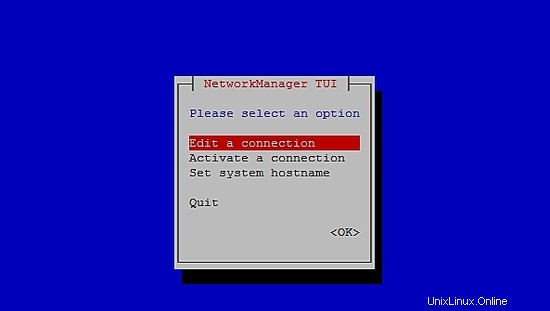
Setelah pengaturan pengaturan jaringan dan nama host pada CentOS 7, jalankan perintah berikut untuk menerapkan perubahan:
service networks restart
Untuk memverifikasi informasi jaringan, jalankan perintah berikut:
ip addr
Outputnya terlihat seperti ini:
1: lo: <LOOPBACK,UP,LOWER_UP> mtu 65536 qdisc noqueue state UNKNOWN qlen 1
link/loopback 00:00:00:00:00:00 brd 00:00:00:00:00:00
inet 127.0.0.1/8 scope host lo
valid_lft forever preferred_lft forever
inet6 ::1/128 scope host
valid_lft forever preferred_lft forever
2: enp0s3: <BROADCAST,MULTICAST,UP,LOWER_UP> mtu 1500 qdisc pfifo_fast state UP qlen 1000
link/ether 08:00:27:67:bc:73 brd ff:ff:ff:ff:ff:ff
inet 10.0.2.15/24 brd 10.0.2.255 scope global dynamic enp0s3
valid_lft 84631sec preferred_lft 84631sec
inet6 fe80::9e25:c982:1091:90eb/64 scope link
valid_lft forever preferred_lft forever
3: enp0s8: <BROADCAST,MULTICAST,UP,LOWER_UP> mtu 1500 qdisc pfifo_fast state UP qlen 1000
link/ether 08:00:27:68:88:f3 brd ff:ff:ff:ff:ff:ff
inet 192.168.56.101/24 brd 192.168.56.255 scope global dynamic enp0s8
valid_lft 1044sec preferred_lft 1044sec
inet6 fe80::a00:27ff:fe68:88f3/64 scope link
valid_lft forever preferred_lft forever
Nonaktifkan SELINUX (Security Enhanced Linux) di Centos 7, edit file konfigurasi berikut:
vim /etc/selinux/config
"/etc/selinux/config" 14L, 547C# This file controls the state of SELinux on the system. # SELINUX= can take one of these three values: # enforcing - SELinux security policy is enforced. # permissive - SELinux prints warnings instead of enforcing. # disabled - No SELinux policy is loaded. SELINUX=enforcing # SELINUXTYPE= can take one of three two values: # targeted - Targeted processes are protected, # minimum - Modification of targeted policy. Only selected processes are prootected. # mls - Multi Level Security protection. SELINUXTYPE=targeted
Ubah nilai menegakkan dari arahan SELINUX ke dinonaktifkan , simpan file dan reboot server.
Untuk mengecek status SELinux pada Centos 7, jalankan perintah berikut:
getenforce
Outputnya harus:
Disabled
Untuk menonaktifkan FirewallD di Centos 7, jalankan perintah berikut:
systemctl disable firewalld
systemctl stop firewalld
Untuk memeriksa status firewall pada Centos 7, jalankan perintah berikut:
systemctl status firewalld
Instal MariaDB, Apache, dan PHP di Centos 7
Untuk menginstal MariaDB di Centos 7, jalankan perintah berikut:
yum -y install mariadb-server
Untuk memulai MariaDB, jalankan perintah berikut:
systemctl start mariadb
Untuk meningkatkan keamanan MariaDB, jalankan perintah berikut:
/usr/bin/mysql_secure_installation
Atur opsi sesuai dengan output berikut atau gunakan preferensi Anda sendiri:
NOTE: RUNNING ALL PARTS OF THIS SCRIPT IS RECOMMENDED FOR ALL MariaDB
SERVERS IN PRODUCTION USE! PLEASE READ EACH STEP CAREFULLY!
In order to log into MariaDB to secure it, we'll need the current
password for the root user. If you've just installed MariaDB, and
you haven't set the root password yet, the password will be blank,
so you should just press enter here.
Enter current password for root (enter for none):<Press Enter>
OK, successfully used password, moving on...
Setting the root password ensures that nobody can log into the MariaDB
root user without the proper authorisation.
Set root password? [Y/n] <Press Y>
Siapkan sandi root:
New password: ******* Re-enter new password: ******* Password updated successfully! Reloading privilege tables.. ... Success! By default, a MariaDB installation has an anonymous user, allowing anyone to log into MariaDB without having to have a user account created for them. This is intended only for testing, and to make the installation go a bit smoother. You should remove them before moving into a production environment. Remove anonymous users? [Y/n] <Press Y>
... Success!
Normally, root should only be allowed to connect from 'localhost'. This
ensures that someone cannot guess at the root password from the network.
Disallow root login remotely? [Y/n] <Choose acording your needs>
... Success!
By default, MariaDB comes with a database named 'test' that anyone can
access. This is also intended only for testing, and should be removed
before moving into a production environment.
Remove test database and access to it? [Y/n] <Press Y>
- Dropping test database...
... Success!
- Removing privileges on test database...
... Success!
Reloading the privilege tables will ensure that all changes made so far
will take effect immediately.
Reload privilege tables now? [Y/n] <Press Y>
... Success!
Cleaning up...
All done! If you've completed all of the above steps, your MariaDB
installation should now be secure.
Thanks for using MariaDB!
Siapkan MariaDB untuk memulai secara otomatis dengan Centos 7:
systemctl enable mariadb.service
Untuk menginstal Apache, jalankan perintah berikut:
yum install httpd
Untuk memulai Apache, jalankan perintah berikut:
systemctl start httpd.service
Siapkan Apache untuk memulai secara otomatis dengan Centos 7:
systemctl enable httpd.service
Untuk menguji Apache, di browser web Anda, ketik alamat IP server Anda. Jika semuanya baik-baik saja, Anda dapat melihat halaman pengujian:
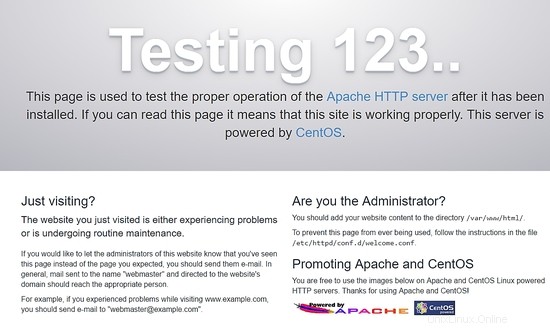
Untuk menginstal PHP, jalankan perintah berikut:
yum install php php-mysql
Restart Apache, jalankan perintah berikut:
systemctl restart httpd.service
Untuk menguji PHP, buat file phpinfo.php di dalam direktori /var/www/html dengan konten berikut:
<?php phpinfo(); ?>
Sekarang Anda dapat mengakses phpinfo.php melalui browser dengan URL berikut: http://[your-ip-addres]/phpinfo.php. Jika semuanya sudah beres, Anda dapat melihat halaman berikut:
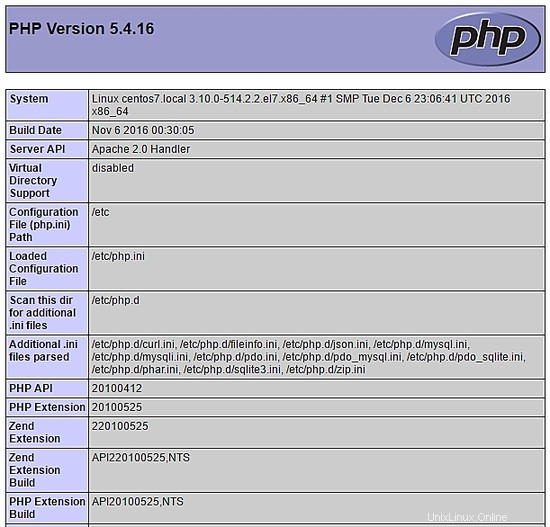
Siapkan database melalui terminal
Akses MariaDB melalui terminal dan buat database bookedscheduler dan pengguna booked_user dengan hak yang cukup untuk mengelola database ini. Jalankan perintah berikut untuk dilakukan melalui terminal:
mysql -u root -p
Buat penjadwal terpesan basis data:
MariaDB [(none)]> create database bookedscheduler;
Buat booked_user di MariaDb:
CREATE USER 'booked_user'@'localhost' IDENTIFIED BY 'your_password';
Berikan izin kepada pengguna booked_user ke penjadwal yang dipesan basis data:
GRANT ALL PRIVILEGES ON database.bookedscheduler TO 'booked_user'@'localhost';
Impor skema dan data database yang dipesan, dari direktori /var/www/html/booked/database_schema/, file sql berikut harus diimpor, create_schema.sql dan buat-data.sql :
mysql -u root -p bookedscheduler < create-schema.sql
mysql -u root -p bookedscheduler < create-data.sql
Siapkan database melalui PHPMyAdmin
Instal PHPMyAdmin di Centos 7 (opsional)
PHPMyAdmin adalah alat untuk mengelola database mysql (mariaDB) dengan cara yang ramah melalui browser. Untuk menginstal phpmyadmin secara otomatis, Anda perlu menginstal repositori Epel, jalankan perintah berikut:
yum install epel-release
Sekarang Anda dapat menjalankan perintah berikut:
yum install phpmyadmin
Setelah penginstalan PHPMyAdmin, kita perlu mengonfigurasinya. Pertama-tama, buat salinan file konfigurasi dan edit file phpMyAdmin.conf di /etc/httpd/conf.d/:
cp /etc/httpd/conf.d/phpMyAdmin.conf /etc/httpd/conf.d/phpMyAdmin.conf.old
vim /etc/httpd/conf.d/phpMyAdmin.conf
Ubah nilainya sesuai dengan lingkungan jaringan Anda, dalam kasus saya, saya mengubah baris berikut (17, 25, 34, 42). File konfigurasi saya terlihat seperti ini:
# phpMyAdmin - Web based MySQL browser written in php
#
# Allows only localhost by default
#
# But allowing phpMyAdmin to anyone other than localhost should be considered
# dangerous unless properly secured by SSL
Alias /phpMyAdmin /usr/share/phpMyAdmin
Alias /phpmyadmin /usr/share/phpMyAdmin
<IfModule mod_authz_core.c>
# Apache 2.4
<RequireAny>
Require ip 127.0.0.1
Require ip 192.168.56.1
Require ip ::1
</RequireAny>
</IfModule>
<IfModule !mod_authz_core.c>
# Apache 2.2
Order Deny,Allow
Deny from All
Allow from 192.168.56.1
Allow from ::1
</IfModule>
<Directory /usr/share/phpMyAdmin/setup/>
<IfModule mod_authz_core.c>
# Apache 2.4
<RequireAny>
Require ip 127.0.0.1
Require ip ::1
</RequireAny>
</IfModule>
<IfModule !mod_authz_core.c>
# Apache 2.2
Order Deny,Allow
Deny from All
Allow from 192.168.56.1
Allow from ::1
</IfModule>
</Directory>
# These directories do not require access over HTTP - taken from the original
# phpMyAdmin upstream tarball
#
<Directory /usr/share/phpMyAdmin/libraries/>
Order Deny,Allow
Deny from All
Allow from None
</Directory>
<Directory /usr/share/phpMyAdmin/setup/lib/>
Order Deny,Allow
Deny from All
Allow from None
</Directory>
<Directory /usr/share/phpMyAdmin/setup/frames/>
Order Deny,Allow
Deny from All
Allow from None
</Directory>
# This configuration prevents mod_security at phpMyAdmin directories from
# filtering SQL etc. This may break your mod_security implementation.
#
#<IfModule mod_security.c>
# <Directory /usr/share/phpMyAdmin/>
# SecRuleInheritance Off
# </Directory>
#</IfModule>
Restart Apache, jalankan perintah berikut:
systemctl restart httpd.service
Sekarang Anda dapat mengakses PHPMyAdmin melalui browser dengan URL berikut: http://[your-ip-addres]/phpMyAdmin/
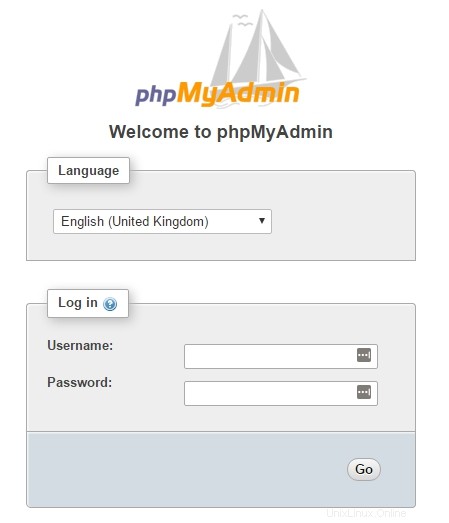
Gunakan root . Anda akun dan sandi yang telah ditentukan sebelumnya pada penginstalan MariaDB untuk membuat database dan pengguna. Di dasbor, pilih Database pilihan untuk membuat database baru:

Isi formulir dengan nama database dan pilih buat .

Untuk mengimpor data database, pada menu sebelah kiri, pilih penjadwal yang dipesan database, dan Impor dari dasbor PHPMyAdmin, pilih file berikut, create-schema.sql (1) dan create-data.sql (2), dari file instalasi dan impor.

Buat pengguna booked_user dengan izin untuk mengelola bookedscheduler basis data. Di dasbor PHPMyAdmin, pilih Pengguna dan Tambahkan :
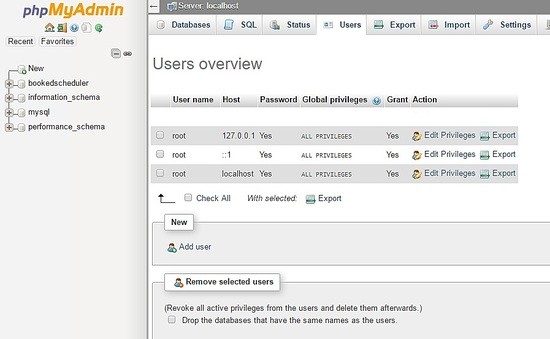
Pada layar pembuatan pengguna, isi bidang dengan database pengguna (booked_user), siapkan kata sandi dan pilih GO di akhir halaman:
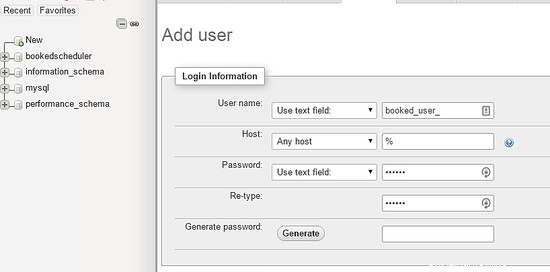
Untuk menyiapkan hak istimewa ke booked_user di penjadwal yang dipesan database, pilih bookedscheduler dari daftar database dan pilih Go:
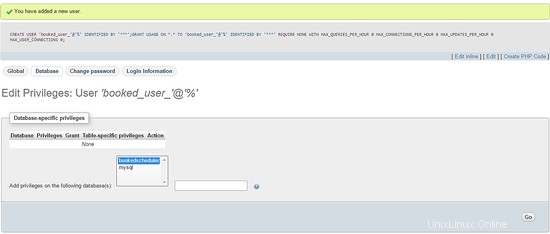
Pada layar hak istimewa, pilih opsi Periksa Semua dan Pergi :
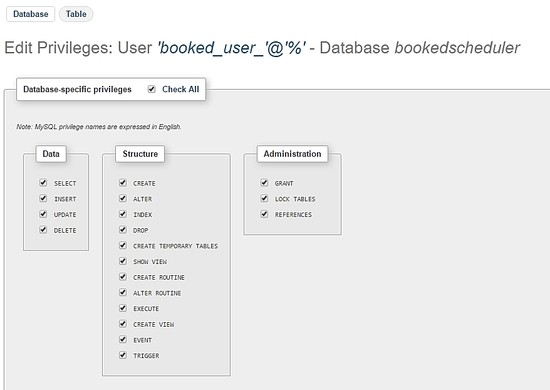
Menginstal Penjadwal yang Dipesan Centos 7
Kami memiliki dua cara untuk menginstal Penjadwal yang Dipesan, manual atau otomatis. Artikel ini hanya mencakup instalasi manual. Untuk menginstal Penjadwal yang Dipesan di Centos 7, buka direktori /tmp dan unduh kode sumbernya:
wget https://ufpr.dl.sourceforge.net/project/phpscheduleit/Booked/2.6/booked-2.6.5.zip
Buka zip file di direktori /var/www/html, jalankan perintah berikut:
unzip booked-2.6.5.zip -d /var/www/html/
Ubah izin file yang tidak di-zip.
cd /var/www/html/
chown -R apache:apache /booked
Siapkan file konfigurasi di /var/www/html/booked/config. Buat salinan file config.dist.php ke config.php dan edit blok file konfigurasi (Ini adalah file konfigurasi saya):
cp config.dist.php config.php
Ubah nilainya sesuai dengan lingkungan kita, berikut saya sajikan pengaturan utama untuk diubah, dan diinformasikan, alamat email akan menjadi admin sistem setelah mendaftar pertama:
<?php
/**
Copyright 2011-2016 Nick Korbel
This file is part of Booked Scheduler.
Booked Scheduler is free software: you can redistribute it and/or modify
it under the terms of the GNU General Public License as published by
the Free Software Foundation, either version 3 of the License, or
(at your option) any later version.
Booked Scheduler is distributed in the hope that it will be useful,
but WITHOUT ANY WARRANTY; without even the implied warranty of
MERCHANTABILITY or FITNESS FOR A PARTICULAR PURPOSE. See the
GNU General Public License for more details.
You should have received a copy of the GNU General Public License
along with Booked Scheduler. If not, see <http://www.gnu.org/licenses/>.
*/
error_reporting(E_ALL & ~E_NOTICE & ~E_STRICT);
//ini_set('display_errors', 1);
//ini_set('display_startup_errors', 1);
/**
* Application configuration
*/
$conf['settings']['app.title'] = 'Booked Scheduler'; // application title
$conf['settings']['default.timezone'] = 'America/Chicago'; // Change your time zone - look up here http://php.net/manual/en/timezones.php
$conf['settings']['allow.self.registration'] = 'true'; // if users can register themselves
$conf['settings']['admin.email'] = '[email protected]'; // fill with the email address of admin user
$conf['settings']['admin.email.name'] = 'Booked Administrator'; // name to be used in From: field when sending automatic emails
$conf['settings']['default.page.size'] = '50'; // number of records per page
$conf['settings']['enable.email'] = 'true'; // global configuration to enable if any emails will be sent
$conf['settings']['default.language'] = 'en_us'; Change acording to your language // find your language in the lang directory
$conf['settings']['script.url'] = 'http://[your-ip-address]/Web'; // public URL to the Web directory of this instance. this is the URL that appears when you are logging in. leave http: or https: off to auto-detect
$conf['settings']['image.upload.directory'] = 'Web/uploads/images'; // full or relative path to where images will be stored
$conf['settings']['image.upload.url'] = 'uploads/images'; // full or relative path to show uploaded images from
$conf['settings']['cache.templates'] = 'true'; // true recommended, caching template files helps web pages render faster
$conf['settings']['use.local.jquery'] = 'false'; // false recommended, delivers jQuery from Google CDN, uses less bandwidth
$conf['settings']['registration.captcha.enabled'] = 'true'; // recommended. unless using recaptcha this requires php_gd2 enabled in php.ini
$conf['settings']['registration.require.email.activation'] = 'true'; // requires enable.email = true
$conf['settings']['registration.auto.subscribe.email'] = 'false'; // requires enable.email = true
$conf['settings']['registration.notify.admin'] = 'true'; // whether the registration of a new user sends an email to the admin (ala phpScheduleIt 1.2)
$conf['settings']['inactivity.timeout'] = '30'; // minutes before the user is automatically logged out
$conf['settings']['name.format'] = '{first} {last}'; // display format when showing user names
$conf['settings']['css.extension.file'] = ''; // full or relative url to an additional css file to include. this can be used to override the default style
$conf['settings']['disable.password.reset'] = 'false'; // if the password reset functionality should be disabled
$conf['settings']['home.url'] = 'your-intranet-portal-url'; // the url to open when the logo is clicked
$conf['settings']['logout.url'] = 'your-intranet-portal-url'; // the url to be directed to after logging out
$conf['settings']['default.homepage'] = '1'; // the default homepage to use when new users register (1 = Dashboard, 2 = Schedule, 3 = My Calendar, 4 = Resource Calendar)
$conf['settings']['schedule']['use.per.user.colors'] = 'false'; // color reservations by user
$conf['settings']['schedule']['show.inaccessible.resources'] = 'true'; // whether or not resources that are inaccessible to the user are visible
$conf['settings']['schedule']['reservation.label'] = '{name}'; // format for what to display on the reservation slot label. Available properties are: {name}, {title}, {description}, {email}, {phone}, {organization}, {position}, {startdate}, {enddate} {resourcename} {participants} {invitees} {reservationAttributes}. Custom attributes can be added using att with the attribute id. For example {att1}
$conf['settings']['schedule']['hide.blocked.periods'] = 'false'; // if blocked periods should be hidden or shown
/**
* ical integration configuration
*/
$conf['settings']['ics']['require.login'] = 'true'; // recommended, if the user must be logged in to access ics files
$conf['settings']['ics']['subscription.key'] = ''; // must be set to allow webcal subscriptions
$conf['settings']['ics']['import'] = 'false'; // enable iCal import
$conf['settings']['ics']['import.key'] = ''; // it's recommended to set this key when iCal import is enabled
/**
* Privacy configuration - Set up here your business rules
*/
$conf['settings']['privacy']['view.schedules'] = 'true'; // if unauthenticated users can view schedules
$conf['settings']['privacy']['view.reservations'] = 'false'; // if unauthenticated users can view reservations
$conf['settings']['privacy']['hide.user.details'] = 'false'; // if personal user details should be displayed to non-administrators
$conf['settings']['privacy']['hide.reservation.details'] = 'false'; // if reservation details should be displayed to non-administrators
$conf['settings']['privacy']['allow.guest.reservations'] = 'false'; // if reservations can be made by users without a Booked account, if true this overrides schedule and resource visibility
/**
* Reservation specific configuration
*/
$conf['settings']['reservation']['start.time.constraint'] = 'future'; // when reservations can be created or edited. options are future, current, none
$conf['settings']['reservation']['updates.require.approval'] = 'false'; // if updates to previously approved reservations require approval again
$conf['settings']['reservation']['prevent.participation'] = 'false'; // if participation and invitation options should be removed
$conf['settings']['reservation']['prevent.recurrence'] = 'false'; // if recurring reservations are disabled for non-administrators
$conf['settings']['reservation']['enable.reminders'] = 'false'; // if reminders are enabled. this requires email to be enabled and the reminder job to be configured
$conf['settings']['reservation']['allow.guest.participation'] = 'false';
$conf['settings']['reservation']['allow.wait.list'] = 'false';
$conf['settings']['reservation']['checkin.minutes.prior'] = '5';
/**
* Email notification configuration
*/
$conf['settings']['reservation.notify']['resource.admin.add'] = 'false';
$conf['settings']['reservation.notify']['resource.admin.update'] = 'false';
$conf['settings']['reservation.notify']['resource.admin.delete'] = 'false';
$conf['settings']['reservation.notify']['resource.admin.approval'] = 'false';
$conf['settings']['reservation.notify']['application.admin.add'] = 'false';
$conf['settings']['reservation.notify']['application.admin.update'] = 'false';
$conf['settings']['reservation.notify']['application.admin.delete'] = 'false';
$conf['settings']['reservation.notify']['application.admin.approval'] = 'false';
$conf['settings']['reservation.notify']['group.admin.add'] = 'false';
$conf['settings']['reservation.notify']['group.admin.update'] = 'false';
$conf['settings']['reservation.notify']['group.admin.delete'] = 'false';
$conf['settings']['reservation.notify']['group.admin.approval'] = 'false';
/**end business rules
* File upload configuration
*/
$conf['settings']['uploads']['enable.reservation.attachments'] = 'false'; // if reservation attachments can be uploaded
$conf['settings']['uploads']['reservation.attachment.path'] = 'uploads/reservation'; // full or relative (to the root of your installation) filesystem path to store reservation attachments
$conf['settings']['uploads']['reservation.attachment.extensions'] = 'txt,jpg,gif,png,doc,docx,pdf,xls,xlsx,ppt,pptx,csv'; // comma separated list of file extensions that users are allowed to attach. leave empty to allow all extensions
/**
* Database configuration
*/
$conf['settings']['database']['type'] = 'mysql';
$conf['settings']['database']['user'] = 'booked_user'; // database user with permission to the booked database
$conf['settings']['database']['password'] = 'your_password'; fill with the booked_user password
$conf['settings']['database']['hostspec'] = '127.0.0.1'; // ip, dns or named pipe
$conf['settings']['database']['name'] = 'bookedscheduler';
/**TIP: if you have problems to conect to database, please, try with the user and passord of root, if it works, go back to user database permitions.
* Mail server configuration
*/To e-mail configurarion I need to use a relay to my e-mail server and in my server I instaled postfix and configurate it to send e-mails
$conf['settings']['phpmailer']['mailer'] = 'mail'; // options are 'mail', 'smtp' or 'sendmail'
$conf['settings']['phpmailer']['smtp.host'] = 'your-mx'; // 'smtp.company.com'
$conf['settings']['phpmailer']['smtp.port'] = '25';
$conf['settings']['phpmailer']['smtp.secure'] = ''; // options are '', 'ssl' or 'tls'
$conf['settings']['phpmailer']['smtp.auth'] = 'true'; // options are 'true' or 'false'
$conf['settings']['phpmailer']['smtp.username'] = '[email protected]';
$conf['settings']['phpmailer']['smtp.password'] = 'your-password';
$conf['settings']['phpmailer']['sendmail.path'] = '/usr/sbin/sendmail';
$conf['settings']['phpmailer']['smtp.debug'] = 'false';
/**
* Plugin configuration. For more on plugins, see readme_installation.html
*/
$conf['settings']['plugins']['Authentication'] = '';
$conf['settings']['plugins']['Authorization'] = '';
$conf['settings']['plugins']['Permission'] = '';
$conf['settings']['plugins']['PostRegistration'] = '';
$conf['settings']['plugins']['PreReservation'] = '';
$conf['settings']['plugins']['PostReservation'] = '';
/**
* Installation settings
*/
$conf['settings']['install.password'] = ''; //just to automated instalation
/**
* Pages
*/
$conf['settings']['pages']['enable.configuration'] = 'true';
/**
* API
*/
$conf['settings']['api']['enabled'] = 'false';
/**
* ReCaptcha
*/
$conf['settings']['recaptcha']['enabled'] = 'false';
$conf['settings']['recaptcha']['public.key'] = '';
$conf['settings']['recaptcha']['private.key'] = '';
/**
*/
$conf['settings']['email']['default.from.address'] = 'your-email-address';
$conf['settings']['email']['default.from.name'] = 'your-system-name';
/**
* Reports
*/
$conf['settings']['reports']['allow.all.users'] = 'false';
/**
* Account Password Rules
*/
$conf['settings']['password']['minimum.letters'] = '6';
$conf['settings']['password']['minimum.numbers'] = '0';
$conf['settings']['password']['upper.and.lower'] = 'false';
/**
* Label display settings
*/
$conf['settings']['reservation.labels']['ics.summary'] = '{title}';
$conf['settings']['reservation.labels']['ics.my.summary'] = '{title}';
$conf['settings']['reservation.labels']['rss.description'] = '<div><span>Start</span> {startdate}</div><div><span>End</span> {enddate}</div><div><span>Organizer</span> {name}</div><div><span>Description</span> {description}</div>';
$conf['settings']['reservation.labels']['my.calendar'] = '{resourcename} {title}';
$conf['settings']['reservation.labels']['resource.calendar'] = '{name}';
$conf['settings']['reservation.labels']['reservation.popup'] = ''; // Format for what to display in reservation popups. Possible values: {name} {dates} {title} {resources} {participants} {accessories} {description} {attributes}. Custom attributes can be added using att with the attribute id. For example {att1}
/**
* Security header settings
*/
$conf['settings']['security']['security.headers'] = 'false'; // Enable the following options
$conf['settings']['security']['security.strict-transport'] = 'true';
$conf['settings']['security']['security.x-frame'] = 'deny';
$conf['settings']['security']['security.x-xss'] = '1; mode=block';
$conf['settings']['security']['security.x-content-type'] = 'nosniff';
$conf['settings']['security']['security.content-security-policy'] = "default-src 'self'"; // Requires careful tuning (know what your doing)
/**
* Google Analytics settings
*/
$conf['settings']['google.analytics']['tracking.id'] = ''; // if set, Google Analytics tracking code will be added to every page in Booked
$conf['settings']['authentication']['allow.facebook.login'] = 'true';
$conf['settings']['authentication']['allow.google.login'] = 'true';
$conf['settings']['authentication']['required.email.domains'] = '';
/**
* Credits functionality
*/
$conf['settings']['credits']['enabled'] = 'false';
Konfigurasi Antarmuka Web Penjadwal yang Dipesan
Akses alamat berikut http://your-ipaddress/Web/index.php, jika semuanya berfungsi dengan baik, Anda akan melihat layar berikut:
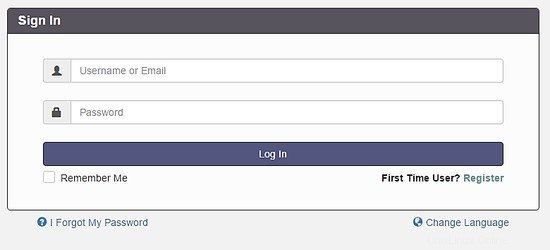
Pilih opsi Daftar untuk membuat akun admin, ingat, gunakan alamat email yang sebelumnya dikonfigurasi di file config.php.
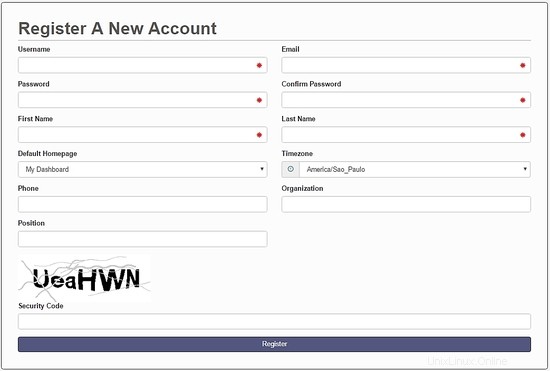
Setelah membuat akun Anda, buka layar login dan autentikasi. Sebuah dashboard akan dimuat, seperti gambar ini:

On the main menu, you can config all system, select Application Management :

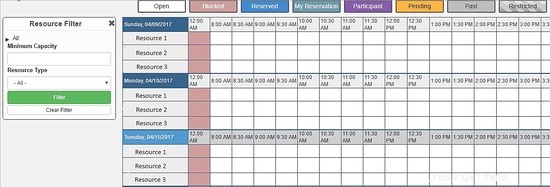
Through this menu, you can configure all resources of Booked Scheduler, to change the config.php, select the Application Configuration :
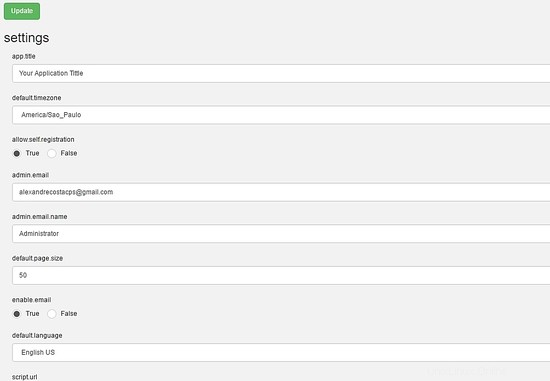
This article is a small overview about Booked Scheduler, this software has a lot of amazing features who can help any environment to provide a rational use of resources.

I hope this article can introduce you to the software, in case you have any problem with the installation, feel free to ask questions. If you want to get more information about Booked Scheduler access http://www.bookedscheduler.com/.